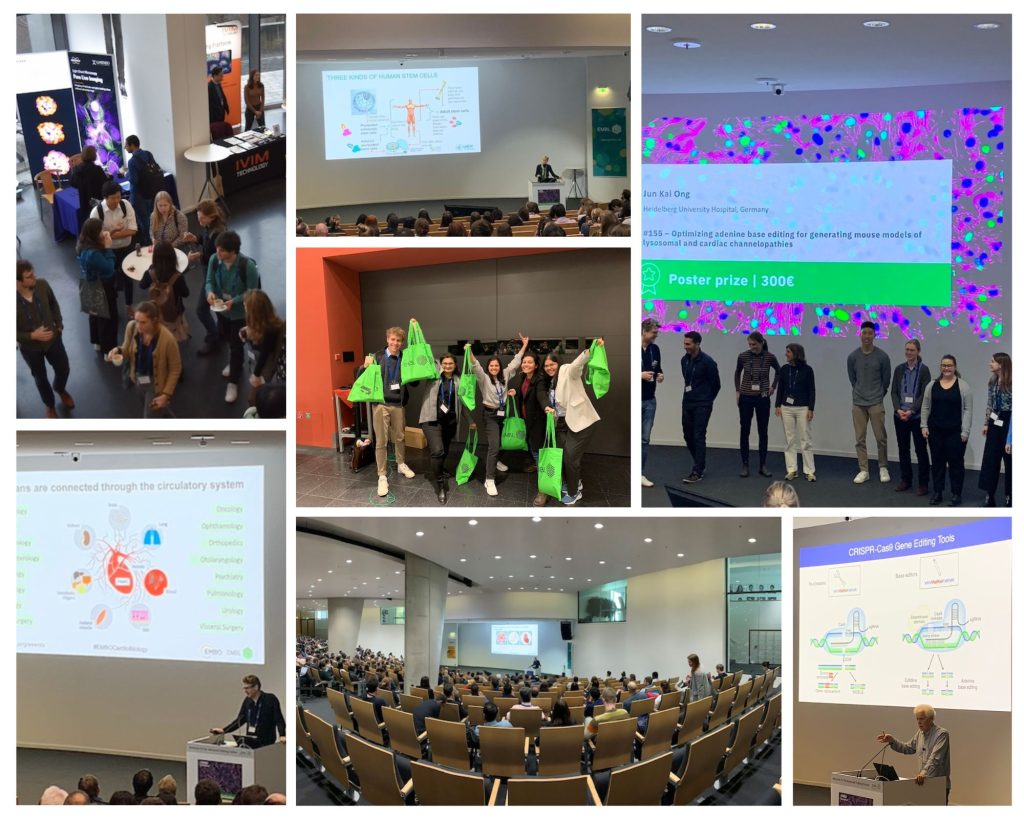Meet the winners of the best poster prize from the EMBO Workshop ‘The new cardiobiology’
The current therapeutic approaches to cardiovascular dysfunction are either organ-centric or tackle the consequences of end-stage cardiovascular disease (CVD).
This new EMBO Workshop around cardiobiology aimed to transform the established organ-centric view on single cardiovascular organs into a systems biomedicine approach by providing space for an exchange of ideas, and tearing down the walls between disciplines.
The session topics during the four days of the conference included
- Where developmental biology meets cardiovascular engineering
- Where engineering meets cardiovascular regeneration
- Where cardiomyocyte biology meets immunology
- Molecular circuits of heart disease
- and more
Next to attending sessions, participants had plenty of time for speed networking, socialising, and were able to meet the speakers and editors of scientific journals during the breaks. In two poster sessions, researchers could showcase their lates findings as well as vote for the best poster.
On the last day, all the votes were counted and five winners were announced. In this blog we are showcasing three of them and their abstracts. Have a look at their amazing work:
Deciphering the mechanism of RBM20 mislocalization in dilated cardiomyopathy identifies a novel therapeutic avenue
Presenter: Julia Kornienko, EMBL Heidelberg, Germany
Collaborators: Marta Rodíguez-Martinez, Kai Fenzl, Daniel Schraivogel, Lars Steinmetz, EMBL Heidelberg, Germany

Abstract: Many human pathologies are associated with aberrant protein localization. Successful development of targeted therapies for such diseases requires understanding of their precise molecular pathomechanisms.
Here, we address the mechanism of pathogenic RBM20 variants that cause severe forms of dilated cardiomyopathy. Mutations in the RS‑domain of RBM20 lead to impairment of mRNA splicing regulation, cytoplasmic RBM20 mislocalization, and formation of RNP granules.
To identify regulators of RBM20 nuclear import in an unbiased way, we performed a genome‑wide CRISPR‑Cas9 screen, and used image‑enabled cell sorting (ICS) to isolate cells with mislocalized RBM20. We identified TNPO3 as the main nuclear importer of RBM20, and showed the direct binding between both proteins. We validated that pathogenic RS‑domain mutations abolish the TNPO3‑RBM20 interaction, which triggers mislocalization of RBM20.
We analyzed splice regulatory activity and protein interactors of RBM20 variants upon their physiological or induced nuclear re‑localization. We showed that nuclear relocalization resulted in restoration of alternative splicing and clearance of cytoplasmic RNP granules. This indicates that RS‑domain RBM20 variants at least partially retain their splicing regulatory activity, and that the main driver of the disease progression is their inability to be efficiently imported into the nucleus. By supplying Tnpo3 with AAV9 to murine hearts, we provide the first evidence that restoring nuclear localization of RBM20 may serve as a promising therapeutic strategy.
Therefore, by identifying the mechanism of mislocalized RBM20, we provide a new therapeutic avenue for RBM20‑DCM patients.
Optimizing adenine base editing for generating mouse models of lysosomal and cardiac channelopathies
Presenter: Jun Kai Ong, Heidelberg University Hospital, Germany
Collaborators: Anouk Dupé, Antonia Schönleber, Alex Cornean, Marc Freichel, Heidelberg University, Germany, Manuel Friese, ZMNH Institut für Neuroimmunologie und Multiple Sklerose, Germany

Abstract: Single nucleotide variants (SNVs) constitute the predominant source of mutations responsible for various human diseases. Many of these SNVs are associated with heart disease, however, the precise disease mechanism is not known. For instance, mutations in the two‑pore channels (TPCs) and transient receptor potential channel (TRPM4) are linked to cardiac dysfunction through global Ca2+ signaling deregulation. Disease modelling of these mutations is crucial to understanding their functional impact and the development of potential therapeutic interventions.
Here, we aimed to generate four mouse disease models: Tpc1I486T, Tpc2K188A, Tpc2L249P and Trpm4L903P, all harbouring A‑to‑G point mutations. Exploiting the advancements in CRISPR‑based gene editing tools, specifically adenine base editors (ABEs), we successfully induced intended A‑to‑G point mutations in three of the targeted genes in vitro using the mouse neuroblastoma cell line N2a. By employing ABE9 fused with the PAM‑flexible SpRY Cas domain, we achieved precise editing of up to 5.13%, and we aim to further enhance the efficiency by optimizing the editing construct and delivery method.
Our preliminary results demonstrate the versatility of the base editing approach in generating specific cardiac disease‑associated point mutations for disease modelling. We are now creating these mouse disease models, which will ultimately facilitate the development of targeted therapeutic interventions.
Poster not available due to unpublished data.
Interplay of metabolism and epigenetics in regulation of heart regeneration
Presenter: Xuejun Yuan, Max Planck Institute for Heart and Lung Research, Germany
Collaborators: Xiang Li, Andreea Bostean, Thomas Braun, Max Planck Institute for Heart and Lung Research, Germany

Abstract: Postnatal maturation of cardiomyocytes is characterized by a metabolic switch from glycolysis to fatty acid oxidation (FAO), chromatin reconfiguration, and exit from cell cycle, instating a barrier for adult heart regeneration.
To explore whether metabolic reprogramming overcomes this barrier and enables heart regeneration, we abrogate FAO in cardiomyocytes by inactivation of Cpt1b. We demonstrate that manipulation of the energy metabolism of heart muscle cells by genetic inactivation of the gene carnitine palmitoyltransferase 1B (Cpt1b) induces a chain of events, which increase the number of heart muscle cells in the mouse heart and enable robust heart regeneration following myocardial infarction.
Fetal and neonatal hearts that are able to regenerate and form new heart muscle cells rely mostly on carbohydrates to produce energy, whereas adult hearts, unable to regenerate, primarily utilize fatty acids. Abrogation of fatty acid oxidation profoundly changes the metabolism of heart muscle cells and causes accumulation of intermediate metabolites alpha‑KG, which also serve as co‑substrates for enzymes that modify the chromatin (complex of DNA and proteins in the nucleus) and thereby regulate gene expression. Increased activity of the enzyme histone demethylase KMD5B due to accumulation of the metabolite alpha‑ketoglutarate reduces expression of cardiac identity genes, which converts heart muscle cells into a less mature state, capable of proliferation and regeneration. Increased proliferation of heart muscle cells in the adult heart by inhibition of fatty acid oxidation well after myocardial infarction reduces scar formation and essentially restores cardiac function within one month.
To further delineate whether the nuclear translocation of metabolic enzymes such as the Isocitrate dehydrogenase (IDH) family proteins contribute to alpha‑ketoglutarate accumulation and enhanced KDM5B activtity in cardiomyocytes during metabolic reprogramming, we aspire to investigate the nuclear function of metabolic enzymes and their contribution to heart regenereation by using Degron‑based technologies for targeted protein depletion in vitro and in vivo.

The EMBO Workshop ‘The new cardiobiology‘ took place from 20 – 23 February 2024 at EMBL Heidelberg and virtually.